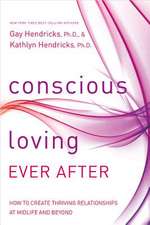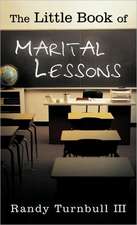The Conscious Heart: Seven Soul-Choices That Create Your Relationship Destiny
Autor Kathlyn Hendricks, Gay Hendricksen Limba Engleză Paperback – 31 ian 1999
These seven simple--but powerful--choices enable couples to:
Use conflict to create greater understanding
Overcome the fears and defenses that block intimacy
Resolve struggles for control
Increase generosity and appreciation
Deepen passion, commitment, and aliveness
Release the creativity of each partner
Filled with numerous true-life stories--including how the authors survived and grew from their own midlife marital crisis--The Conscious Heart is an inspiring and instructive affirmation of the ultimate power of love.
Preț: 109.54 lei
Nou
Puncte Express: 164
Preț estimativ în valută:
20.96€ • 21.94$ • 17.34£
20.96€ • 21.94$ • 17.34£
Carte disponibilă
Livrare economică 15-29 martie
Preluare comenzi: 021 569.72.76
Specificații
ISBN-13: 9780553374919
ISBN-10: 0553374915
Pagini: 320
Dimensiuni: 133 x 210 x 21 mm
Greutate: 0.3 kg
Editura: Bantam
ISBN-10: 0553374915
Pagini: 320
Dimensiuni: 133 x 210 x 21 mm
Greutate: 0.3 kg
Editura: Bantam
Notă biografică
Kathlyn Hendricks, Ph.D., and Gay Hendricks, Ph.D., are nationally known psychotherapists, teachers and workshop leaders. They have been partners in life and work for twenty years, and direct the Hendricks Institute in Santa Barbara, California.
Extras
Seven Soul-Commitments That Allow the Conscious Heart to Thrive
Any time not spent on love is wasted.
--TASSO
In the first two years of our own relationship, we spent much time finding out what true commitment was all about. We had no models to follow. Our parents had married into traditional relationship that emphasized duty and hard work. They had lived through the hardships of the Depression and the war and had firsthand familiarity with scarcity and sacrifice. Both our families lost lands and businesses in the political and economic upheavals of those times. Afterward they valued stability and lifetime commitment. As of this writing, Kathlyn's parents are approaching their fifty-first wedding anniversary. As we were growing up, it was difficult to see how a lifetime commitment could work except by denying feelings, settling into unquestioned roles, or sliding into sleepwalking.
As we began to inquire into it, we saw that most people were focusing on the wrong kind of commitment. They were making outcome commitments rather than process commitments. An example of an outcome commitment is: "I will stick by you through thick and thin until death do us part." It focuses on the outcome, on the goal rather than the journey, ignoring the fact that outcomes can't be controlled. In a process commitment two people make an agreement about how they will travel together, not about where they are going. Process commitments focus on things that are absolutely within their control, such as telling the truth, keeping agreements, and listening nonjudgmentally.
By making soul-level commitments to seven specific processes--each of which is completely within your control--you take ownership of a reliable map of the path. Then reaching the destination becomes a real possibility.
THE SEVEN SOUL-COMMITMENTS
As our relationship grew in depth and understanding, we found that there were seven major process commitments that really made a difference. We took years to develop, understand, and embrace these commitments in our souls. Once we did, however, the heart-level satisfaction of our relationship became much more profound. Here are the commitments that we discovered to be essential:
The First Soul-Commitment
I commit to realizing my full potential for both closeness and autonomy. I open myself to learning about and honoring my essence-rhythms of closeness and separateness, and to learning about and honoring those rhythms in others.
The Second Soul-Commitment
I commit to full expression, to holding back nothing. This means telling the truth about everything, including my feelings, my fantasies, and my actions. I commit to telling the unarguable truth--truth that no one can argue with--instead of giving my opinions, beliefs, and prejudices. I also commit to listening, nonjudgmentally, to what people say to me.
The Third Soul-Commitment
I commit to becoming the source of full responsibility for my life, including my happiness, my well-being, and my life-goals. I absolve everyone, living or dead, past or present, from any implication that they cause my feelings or actions in any way.
The Fourth Soul-Commitment
When faced with the choice between being happy and being defensive, I commit to choosing happiness. I commit to doing this especially in those situations when my defensiveness seems most warranted and when it is totally obvious to me that I am right and the other person is wrong.
The Fifth Soul-Commitment
I commit to learning to love and appreciate myself and others in my close relationships.
The Sixth Soul-Commitment
I commit to the full expression of my creativity, and to inspiring the full creative expression of those around me.
The Seventh Soul-Commitment
I commit to celebration as the dominant emotional tone of my relationships. Particularly, I commit to celebrating the essence of myself and those close to me.
As you step into these soul-commitments, you may find, as we did, that you have stepped off the shore and into a vast ocean of possibilities and currents. As we learned to appreciate the daily challenges of riding the waves of discovery, we sometimes tumbled and rolled with an unexpected swell.
COMMITTING TO CLOSENESS AND AUTONOMY
We came from very different places on the autonomy spectrum: Gay was from the "don't fence me in" school of autonomy, while Kathlyn was from the "devoted to the point of self-sacrifice" school. At first each of us thought our own path was the only correct one. If only the other could be like me, each of us would wistfully think. As we matured, though, we saw that our real growth came from accepting each other's way of being as our teacher. For Gay, one of the key learnings of his life was to let go of some of his go-it-aloneness: "I had always been a loner ever since my childhood. There were few other kids in the neighborhood and they were mostly older, so I spent a lot of time playing by myself. As I got into close relationships in high school and college, I still held back a large part of myself. One time I took my girlfriend and a friend of hers to my dorm room to get something, and the friend exclaimed, "There's nothing on the walls--no posters or anything! There's no personality.' My girlfriend replied dryly, "That is his personality.' It stung, but I knew what she meant.
"When I started my relationship with Kathlyn, I was thirty-five and ready to make some major revisions in my personality. I realized that my loner script, which had worked well for me as a survival strategy growing up, was now costing me. The more I defended myself with it, the less intimacy I enjoyed. I began to study Kathlyn's style of being with people. She touched them a lot, listened to their feelings, cared for them in ways that I felt were mushy. But as I tried on some of her ways of being, I found I liked them. They gave me a softer, more tolerant way of connecting with other people."
Meanwhile, Kathlyn was studying Gay's style: "I noticed that Gay was completely comfortable being by himself, whereas I often got scared when alone and kept myself busy to avoid the fear. Gay could go into a room by himself, write for several hours, and come out feeling happier than when he went in. That was tough for me, and I could see that my discomfort was keeping me from being as creative as I could be. On the other hand, he avoided parties, small talk, and schmoozing, often feeling drained and grouchy if he had to make more than a polite appearance at a party. At first I criticized him for being a lone wolf, but later I began to admire him for it. I tried creating boundaries for myself. Instead of saying yes to every demand on my time, I adopted Gay's ways of saying no to the dozens of people who were always trying to get his attention. I feel like I am so much more of a whole person now that I have more of a balance between my autonomy and being close."
Then we began to question whether our adapted rhythms were our essence-rhythms. In other words, did Gay's essence really thrive when he was alone, and did Kathlyn feel most in touch with herself around other people? Or had these styles evolved in response to our early familial contexts? Gay spent much of his childhood around adults who carried on their grownup routines. He learned to create a rich inner life while on car trips with his mother and aunts. Kathlyn, on the other hand, was the middle child between two boys, who did pretty typical boy activities like building forts and racing around the neighborhood on bicycles. Kathlyn particularly adored her older brother and adopted a "me too" style in order to be included.
Probably our essential natures led us toward these adaptations. Certainly Gay requires a certain amount of alone-time to feel in touch with himself that Kathlyn doesn't require. But we have found, as have our clients and workshop participants, that the dance of unity-autonomy is the baseline in all relationships. It is such a strong pulsation in the relationship that everything else is built on the subtle exchanges and tides of moving closer and getting separate.
Once we had clarified the source of our particular rhythms, we could give more attention to our day-to-day dance of closeness and separateness. We realized that we had been expecting this dance to be symmetrical, like a minuet. We had imagined that if we really cared for each other, we would want to be close and then alone in a completely harmonious rhythm. We were startled, to say the least, to discover that the dance is almost always asymmetrical. We almost never operated at exactly the same pace. For example, one of us would swirl in for some closeness just as the other was withdrawing into a book.
Subtle changes in breathing and expression that we unconsciously read in each other give us clues about each other's needs. Sometimes we read them accurately and sometimes not, based on our ability to see essence clearly. We've found it's a lot more effective for each of us to tell the truth about the sensations and thoughts that signal our own preferences as they occur. A simple communication like "I notice I'm feeling some pressure in my forehead, and I'd like to take some time to sit out in the garden alone" can save days of mind-reading, sabotaging, and distancing.
The important thing to remember is that all of us have needs both for closeness and for alone-time. If you come from a background where you developed an ease for being by yourself, your learning edge may be to cultivate that same ease for being with people. If you are by nature comfortable with closeness, your learning edge may be to get comfortable with yourself as your only company.
Any time not spent on love is wasted.
--TASSO
In the first two years of our own relationship, we spent much time finding out what true commitment was all about. We had no models to follow. Our parents had married into traditional relationship that emphasized duty and hard work. They had lived through the hardships of the Depression and the war and had firsthand familiarity with scarcity and sacrifice. Both our families lost lands and businesses in the political and economic upheavals of those times. Afterward they valued stability and lifetime commitment. As of this writing, Kathlyn's parents are approaching their fifty-first wedding anniversary. As we were growing up, it was difficult to see how a lifetime commitment could work except by denying feelings, settling into unquestioned roles, or sliding into sleepwalking.
As we began to inquire into it, we saw that most people were focusing on the wrong kind of commitment. They were making outcome commitments rather than process commitments. An example of an outcome commitment is: "I will stick by you through thick and thin until death do us part." It focuses on the outcome, on the goal rather than the journey, ignoring the fact that outcomes can't be controlled. In a process commitment two people make an agreement about how they will travel together, not about where they are going. Process commitments focus on things that are absolutely within their control, such as telling the truth, keeping agreements, and listening nonjudgmentally.
By making soul-level commitments to seven specific processes--each of which is completely within your control--you take ownership of a reliable map of the path. Then reaching the destination becomes a real possibility.
THE SEVEN SOUL-COMMITMENTS
As our relationship grew in depth and understanding, we found that there were seven major process commitments that really made a difference. We took years to develop, understand, and embrace these commitments in our souls. Once we did, however, the heart-level satisfaction of our relationship became much more profound. Here are the commitments that we discovered to be essential:
The First Soul-Commitment
I commit to realizing my full potential for both closeness and autonomy. I open myself to learning about and honoring my essence-rhythms of closeness and separateness, and to learning about and honoring those rhythms in others.
The Second Soul-Commitment
I commit to full expression, to holding back nothing. This means telling the truth about everything, including my feelings, my fantasies, and my actions. I commit to telling the unarguable truth--truth that no one can argue with--instead of giving my opinions, beliefs, and prejudices. I also commit to listening, nonjudgmentally, to what people say to me.
The Third Soul-Commitment
I commit to becoming the source of full responsibility for my life, including my happiness, my well-being, and my life-goals. I absolve everyone, living or dead, past or present, from any implication that they cause my feelings or actions in any way.
The Fourth Soul-Commitment
When faced with the choice between being happy and being defensive, I commit to choosing happiness. I commit to doing this especially in those situations when my defensiveness seems most warranted and when it is totally obvious to me that I am right and the other person is wrong.
The Fifth Soul-Commitment
I commit to learning to love and appreciate myself and others in my close relationships.
The Sixth Soul-Commitment
I commit to the full expression of my creativity, and to inspiring the full creative expression of those around me.
The Seventh Soul-Commitment
I commit to celebration as the dominant emotional tone of my relationships. Particularly, I commit to celebrating the essence of myself and those close to me.
As you step into these soul-commitments, you may find, as we did, that you have stepped off the shore and into a vast ocean of possibilities and currents. As we learned to appreciate the daily challenges of riding the waves of discovery, we sometimes tumbled and rolled with an unexpected swell.
COMMITTING TO CLOSENESS AND AUTONOMY
We came from very different places on the autonomy spectrum: Gay was from the "don't fence me in" school of autonomy, while Kathlyn was from the "devoted to the point of self-sacrifice" school. At first each of us thought our own path was the only correct one. If only the other could be like me, each of us would wistfully think. As we matured, though, we saw that our real growth came from accepting each other's way of being as our teacher. For Gay, one of the key learnings of his life was to let go of some of his go-it-aloneness: "I had always been a loner ever since my childhood. There were few other kids in the neighborhood and they were mostly older, so I spent a lot of time playing by myself. As I got into close relationships in high school and college, I still held back a large part of myself. One time I took my girlfriend and a friend of hers to my dorm room to get something, and the friend exclaimed, "There's nothing on the walls--no posters or anything! There's no personality.' My girlfriend replied dryly, "That is his personality.' It stung, but I knew what she meant.
"When I started my relationship with Kathlyn, I was thirty-five and ready to make some major revisions in my personality. I realized that my loner script, which had worked well for me as a survival strategy growing up, was now costing me. The more I defended myself with it, the less intimacy I enjoyed. I began to study Kathlyn's style of being with people. She touched them a lot, listened to their feelings, cared for them in ways that I felt were mushy. But as I tried on some of her ways of being, I found I liked them. They gave me a softer, more tolerant way of connecting with other people."
Meanwhile, Kathlyn was studying Gay's style: "I noticed that Gay was completely comfortable being by himself, whereas I often got scared when alone and kept myself busy to avoid the fear. Gay could go into a room by himself, write for several hours, and come out feeling happier than when he went in. That was tough for me, and I could see that my discomfort was keeping me from being as creative as I could be. On the other hand, he avoided parties, small talk, and schmoozing, often feeling drained and grouchy if he had to make more than a polite appearance at a party. At first I criticized him for being a lone wolf, but later I began to admire him for it. I tried creating boundaries for myself. Instead of saying yes to every demand on my time, I adopted Gay's ways of saying no to the dozens of people who were always trying to get his attention. I feel like I am so much more of a whole person now that I have more of a balance between my autonomy and being close."
Then we began to question whether our adapted rhythms were our essence-rhythms. In other words, did Gay's essence really thrive when he was alone, and did Kathlyn feel most in touch with herself around other people? Or had these styles evolved in response to our early familial contexts? Gay spent much of his childhood around adults who carried on their grownup routines. He learned to create a rich inner life while on car trips with his mother and aunts. Kathlyn, on the other hand, was the middle child between two boys, who did pretty typical boy activities like building forts and racing around the neighborhood on bicycles. Kathlyn particularly adored her older brother and adopted a "me too" style in order to be included.
Probably our essential natures led us toward these adaptations. Certainly Gay requires a certain amount of alone-time to feel in touch with himself that Kathlyn doesn't require. But we have found, as have our clients and workshop participants, that the dance of unity-autonomy is the baseline in all relationships. It is such a strong pulsation in the relationship that everything else is built on the subtle exchanges and tides of moving closer and getting separate.
Once we had clarified the source of our particular rhythms, we could give more attention to our day-to-day dance of closeness and separateness. We realized that we had been expecting this dance to be symmetrical, like a minuet. We had imagined that if we really cared for each other, we would want to be close and then alone in a completely harmonious rhythm. We were startled, to say the least, to discover that the dance is almost always asymmetrical. We almost never operated at exactly the same pace. For example, one of us would swirl in for some closeness just as the other was withdrawing into a book.
Subtle changes in breathing and expression that we unconsciously read in each other give us clues about each other's needs. Sometimes we read them accurately and sometimes not, based on our ability to see essence clearly. We've found it's a lot more effective for each of us to tell the truth about the sensations and thoughts that signal our own preferences as they occur. A simple communication like "I notice I'm feeling some pressure in my forehead, and I'd like to take some time to sit out in the garden alone" can save days of mind-reading, sabotaging, and distancing.
The important thing to remember is that all of us have needs both for closeness and for alone-time. If you come from a background where you developed an ease for being by yourself, your learning edge may be to cultivate that same ease for being with people. If you are by nature comfortable with closeness, your learning edge may be to get comfortable with yourself as your only company.
Recenzii
"If you want to take your relationship to the deepest level of joy and intimacy, read this book."
--John Gray
"A remarkable road map to the heart."
--NAPRA ReView
"Superb--Worth two readings, minimum."
--The Phoenix
"An exhilarating guide to transforming your closest relationships. After twenty-three years of marriage, it was just what the doctor ordered for both my husband and me."
--Christiane Northrup, M.D. author of Women's Bodies, Women's Wisdom
--John Gray
"A remarkable road map to the heart."
--NAPRA ReView
"Superb--Worth two readings, minimum."
--The Phoenix
"An exhilarating guide to transforming your closest relationships. After twenty-three years of marriage, it was just what the doctor ordered for both my husband and me."
--Christiane Northrup, M.D. author of Women's Bodies, Women's Wisdom
Descriere
This long-awaited sequel to "Conscious Living" explores the seven crucial choices that can transform relationships, thus offering the keys to passion, intimacy, and personal growth.


























